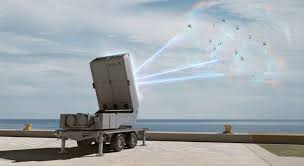My Article published on the EurasianTimes Website on 28 Mar 25.
The most recent and significant news, announced in March 2025, is that Epirus Inc., a defence technology start-up based in Torrance, California, has unveiled the Leonidas system, a high-power microwave (HPM) weapon designed to neutralise unmanned aerial vehicle (UAV) swarms. This innovative system emits electromagnetic pulses to disable drones individually or across a broad area, offering a scalable solution to counter drone threats. The Leonidas system has been likened to a “Star Trek-style” shield due to its ability to disable or destroy drones within seconds. Beyond its counter-drone capabilities, the Leonidas system’s versatility allows it to disable electronics in ground vehicles and sea vessels, demonstrating its potential across various defences.
In the rapidly evolving landscape of modern warfare, unmanned aerial systems (UAS) have emerged as a significant and multifaceted threat. Due to their high operational costs and limited ammunition capacity, traditional defence mechanisms, such as missiles or anti-aircraft guns, struggle to keep pace with these agile, numerous, and often low-cost adversaries. The Leonidas system addresses these challenges through directed energy technology, allowing for rapid, reusable, and cost-effective simultaneous engagement of multiple threats.
Named after the legendary Spartan king who famously stood against overwhelming odds at Thermopylae, the Leonidas system embodies a bold and forward-thinking approach to defence. Leveraging cutting-edge HPM technology, it offers a non-kinetic alternative to conventional systems, addressing one of the most pressing challenges of the 21st century.
High-Power Microwave Technology. HPM systems generate electromagnetic waves ranging from 300 MHz to 300 GHz. Unlike the microwaves used in household ovens to heat food by exciting water molecules, HPM delivers intense bursts of energy capable of inducing currents in electronic circuits. When directed at a target, these microwaves can disrupt or permanently damage sensitive components, rendering devices like drones inoperable. HPM’s ability to affect a broader area rather than a single pinpoint sets it apart from other directed energy technologies, such as lasers. This makes it particularly effective against multiple targets or swarms, a critical advantage in scenarios where dozens or hundreds of drones might be deployed simultaneously. Historically, HPM systems relied on vacuum tube technology, which was bulky, fragile, and maintenance-intensive. However, recent advancements in solid-state electronics have revolutionised the field. Solid-state HPM systems, like the one powering Leonidas, use semiconductor devices to generate microwaves, offering greater durability, efficiency, and compactness, attributes that make the technology viable for real-world deployment.
The Leonidas System.
The Leonidas system is a pinnacle of Epirus’s expertise in solid-state HPM technology. While proprietary details remain closely guarded, the key aspects of its design and functionality can be based on the general principles of HPM and publicly available information.
At its core, the system likely features an array of solid-state amplifiers that generate and amplify microwave signals. These signals are then emitted through a steerable antenna, allowing operators to direct the HPM beam toward specific targets or areas. The power output of the Leonidas system would be a critical factor in its effectiveness. Although exact specifications are not disclosed, HPM systems typically produce peak powers ranging from hundreds of kilowatts to several megawatts. This energy is sufficient to disable the electronics of drones within a specific range, which depends on factors such as power levels, frequency, and atmospheric conditions. Unlike lasers, which maintain a tight beam over long distances, HPM waves experience divergence and can be attenuated by moisture or particles in the air, potentially limiting their range. However, this constraint is less significant for counter-drone applications where threats are often within a few kilometers.
Advanced targeting and control systems are integral to the Leonidas platform. These likely include radar or optical sensors to detect and track drones, paired with sophisticated software that prioritises targets and adjusts the beam’s intensity and direction. The result is a highly responsive system capable of engaging fast-moving threats with near-instantaneous effect, as HPM travels at the speed of light. These systems also enable the Leonidas to distinguish between friendly and hostile drones, reducing the risk of friendly fire and enhancing its effectiveness in complex operational environments.
Epirus has developed fixed and mobile versions of the Leonidas system, enhancing its versatility. Stationary installations might protect critical infrastructure, while vehicle-mounted units could support troops in the field, offering a flexible defence against dynamic threats.
Applications
The primary mission of the Leonidas system is to counter drone threats, a capability that addresses a growing concern in military and civilian contexts. The Leonidas system excels in such scenarios, using its wide-area HPM effects to disable multiple drones with a single burst. This makes it an ideal solution for protecting military installations, convoys, or naval vessels from both individual and coordinated drone attacks.
Beyond counter-drone operations, the Leonidas system holds promise for electronic warfare. Targeting enemy communication systems, radars, or other electronic equipment could degrade an adversary’s situational awareness or operational capabilities without firing a shot. Additionally, the technology might be adapted to disable vehicles or machinery reliant on electronic controls, though this could require higher power levels or closer proximity to the target.
Epirus has also hinted at broader applications, such as non-lethal uses for perimeter security or crowd control. In these scenarios, HPM could deter intrusions or disable unauthorised devices without causing permanent harm, offering a versatile tool for law enforcement or homeland security.
Advantages.
The Leonidas system offers several compelling advantages over conventional kinetic defence systems, making it a game-changer in the fight against emerging threats.
-
- Cost-Effectiveness. Engaging a target with HPM requires only electrical energy, a fraction of the cost of expending missiles or ammunition. This is particularly advantageous against low-cost drones, where using expensive munitions is economically unsustainable.
- Precision and Control. Operators can tune the system to affect specific areas or targets, minimising collateral damage. Adjusting power output in real time allows it to respond to varying threat levels with tailored precision.
- Scalability. From small consumer drones to larger military UAS, the Leonidas system can adapt its energy output to neutralise a wide range of targets, offering flexibility across different operational contexts.
- Unlimited Magazine. Unlike guns or missile launchers with finite ammunition, the Leonidas system can operate continuously as long as it has power, making it ideal for prolonged engagements or swarm attacks.
Challenges
Despite its promise, the Leonidas system faces several technical and operational challenges that must be addressed for widespread adoption:-
-
- Power Requirements. Generating high-power microwaves demands significant electrical energy. For mobile deployments, this necessitates robust power sources, such as large batteries or generators that could limit the system’s portability or require frequent recharging.
-
- Range and Environmental Limitations. HPM’s effectiveness decreases with distance due to beam divergence and atmospheric absorption. Adverse weather conditions, such as rain or fog, could further reduce performance, potentially requiring multiple units for comprehensive coverage.
-
- Integration with Existing Systems. Incorporating a novel technology like HPM into established defence frameworks involves significant hurdles. This includes adapting hardware, training personnel, and developing tactics to maximise its utility alongside traditional systems.
-
- Unintended Disruptions. HPM’s broad-area effects could inadvertently interfere with friendly electronics, communication networks, or civilian infrastructure if not carefully managed. Robust targeting and safety protocols are essential to mitigate this risk.
-
- Strategic Considerations. While primarily defensive, the ability to disable electronics at a distance raises questions about potential offensive applications or escalation in conflicts. International laws and treaties governing directed energy weapons may need to evolve to address these concerns and ensure responsible use.
Impact and Future Prospects
Epirus has successfully tested the Leonidas system, showcasing its ability to neutralise drone swarms with precision and speed. These demonstrations have attracted global attention from military and defence organisations, underscoring the system’s potential to fill a critical gap in countermeasures. Partnerships with defence contractors or government agencies signal growing confidence in HPM technology and its readiness for operational deployment.
Looking to the future, Epirus may enhance the Leonidas system with more significant power outputs to tackle more prominent or more resilient targets. Integration with complementary technologies, such as lasers, could create a multi-layered defence system, combining HPM’s wide-area effects with a laser’s pinpoint accuracy. Advances in artificial intelligence and machine learning could also enable autonomous operation, allowing the system to detect, prioritise, and engage threats in complex environments with minimal human intervention.
The broader implications of the Leonidas system extend beyond immediate defence needs. As directed-energy weapons gain traction, they could influence global military strategies, potentially sparking an arms race or prompting new regulatory frameworks. For now, its focus on countering drones positions it as a vital tool in an increasingly drone-dominated world.
Global DEW Projects
Directed energy weapons (DEWs) are advanced technologies that use focused energy, such as lasers or microwaves, to disable or destroy targets without physical projectiles. Numerous countries are researching and developing these weapons, each with unique projects and strategic goals.
United States. The US is a leader in DEW development. Besides Leonidas, the Department of Defence (DOD) and agencies like DARPA, the Air Force Research Laboratory, and the Naval Research Laboratory are researching DEWs to counter ballistic missiles and hypersonic cruise missiles. Notable projects include the High-Energy Laser Scaling Initiative (HELSI) and systems like HELIOS, with demonstrations successfully shooting down drones.
China. China is making rapid strides in DEW development, with a focus on high-energy lasers and microwave systems. State media and manufacturers have released images of handheld and vehicle-mounted laser systems, including the LW-30, a 30kW road-mobile high-energy laser (HEL) designed for unmanned aerial systems (UAS) and precision-guided weapons. Their efforts extend to counter space applications, with ground-based DEWs potentially targeting satellites, as highlighted in analyses.
Russia. Russia has been developing DEWs for decades, with the Peresvet laser weapon system entering experimental combat duty in 2018 and claimed operational use during the 2022 invasion of Ukraine. A more advanced version, “Zadira,” can incinerate targets up to three miles away within five seconds. Russia is also working on EMP cannons and microwave guns for anti-drone applications.
United Kingdom. The UK’s Ministry of Defence (MOD) is investing heavily in DEWs, with projects like DragonFire, a laser-directed energy weapon (LDEW) that achieved its first high-power firing against aerial targets in January 2024 at the Hebrides Range. DragonFire, with a range classified but capable of hitting a £1 coin from a kilometer away, is expected to be deployable by 2027. Additionally, the Radio Frequency Directed Energy Weapon (RFDEW) is nearing service by 2026, focusing on countering unmanned systems.
France and Germany. France and Germany are key players in European DEW development, often through multinational collaborations. France is involved in projects like the TALOS-TWO, involving 21 partners across eight EU nations. Germany is focusing on integrating DEWs into defence platforms. These efforts aim for operational deployment by 2030, emphasising cost-effective counter-drone and missile defence systems.
India. India’s Defence Research and Development Organisation (DRDO) is actively pursuing DEWs, with projects like the Directionally Unrestricted Ray-Gun Array (DURGA II), a 100-kilowatt lightweight DEW at the concept stage, set for integration with land, sea, and air platforms. Other initiatives include the KALI particle accelerator and a 1KW laser weapon for counter-IED operations, with plans for 25-kW and 100-kW systems.
Israel. Israel is advancing the Iron Beam laser-based DEW, designed to complement its Iron Dome system. A contract signed in October 2024 for operational service within a year reflects its cost-effectiveness. The US has allocated $1.2 billion for Iron Beam procurement.
Iran and Turkey. They claim DEWs in active service, adding controversy to global assessments. Iran has announced developments in laser air defence systems, while Turkey claims the ALKA DEW was used in combat in Libya in 2019. However, specifics and verification are scarce, with claims often met with scepticism due to limited transparency.
South Korea, Japan, and Australia. South Korea and Japan have advanced technological capabilities, with South Korea developing laser-based systems for counter-drone applications, though less prominently than significant powers. Japan focuses more on nuclear and space technologies, with limited public DEW projects. Australia is investing in DEW technology, particularly for countering drones, with a $13 million deal with QinetiQ for a prototype defensive laser.
Conclusion
The Leonidas system by Epirus marks a transformative advancement in modern defence. It harnesses high-power microwave technology to address the escalating threat of drones and electronic-based hazards. Its non-kinetic approach offers a cost-effective, precise, and scalable solution that outperforms traditional systems in key areas, from countering swarms to enabling electronic warfare. While challenges such as power demands, environmental constraints, and integration remain, the system’s successful demonstrations and growing adoption signal its readiness to make a lasting impact.
The future of Directed Energy Weapons (DEWs) is promising, with advancements in laser, microwave, and particle beam technologies enhancing their effectiveness. These weapons offer rapid engagement, precision targeting, and cost efficiency, making them invaluable for missile defence, drone neutralisation, and electronic warfare. However, hurdles such as energy storage, environmental limitations, and legal-ethical concerns must be overcome. As nations invest in DEW research, their role in modern warfare will expand, shaping the next generation of defence capabilities.
Please Do Comment.
For regular updates, please register your email here:-
References and credits
To all the online sites and channels.
Pics Courtesy: Internet
Disclaimer:
Information and data included in the blog are for educational & non-commercial purposes only and have been carefully adapted, excerpted, or edited from reliable and accurate sources. All copyrighted material belongs to respective owners and is provided only for wider dissemination.
Link to the article on the website:-
References:-
- Epirus Inc. “Leonidas High-Power Microwave: Directed Energy for Counter-Unmanned Aerial Systems (cUAS).” Epirus Official Website.
- DefenceScoop. “Marines to Get New Drone-Killing Microwave Weapon Designed for Expeditionary Operations.” DefenceScoop, September 23, 2024.
- Axios. “Drone-Frying Defence Firm Epirus Raises $250 Million.” Axios, March 5, 2025.
- Reuters. “Defence Tech Startup Epirus Secures $250 Million to Make Anti-Drone Weapons.” Reuters, March 5, 2025.
- Army Technology. “Leonidas High-Power Microwave System, US.” Army Technology, August 2024.
- Unmanned Airspace. “Epirus to Deliver Leonidas Expeditionary Air Defence System to US Navy.” Unmanned Airspace, September 2024.
- NightDragon. “Building the Future of Air Defense: Our Investment in Epirus.” NightDragon Insights, March 2025.
- “The Future of War: How Directed Energy Weapons Are Changing Military Strategy.” Defence One, October 2023.
- “Laser Weapons and High-Power Microwaves: The Pentagon’s Next-Generation Arsenal.” The National Interest, November 2023.
- “Directed Energy Weapons and the Challenge of Counter-Drone Warfare.” C4ISRNET, July 2024.
- “How Lasers and Microwaves Are Redefining the Battlefield.” Defense News, August 2024.



